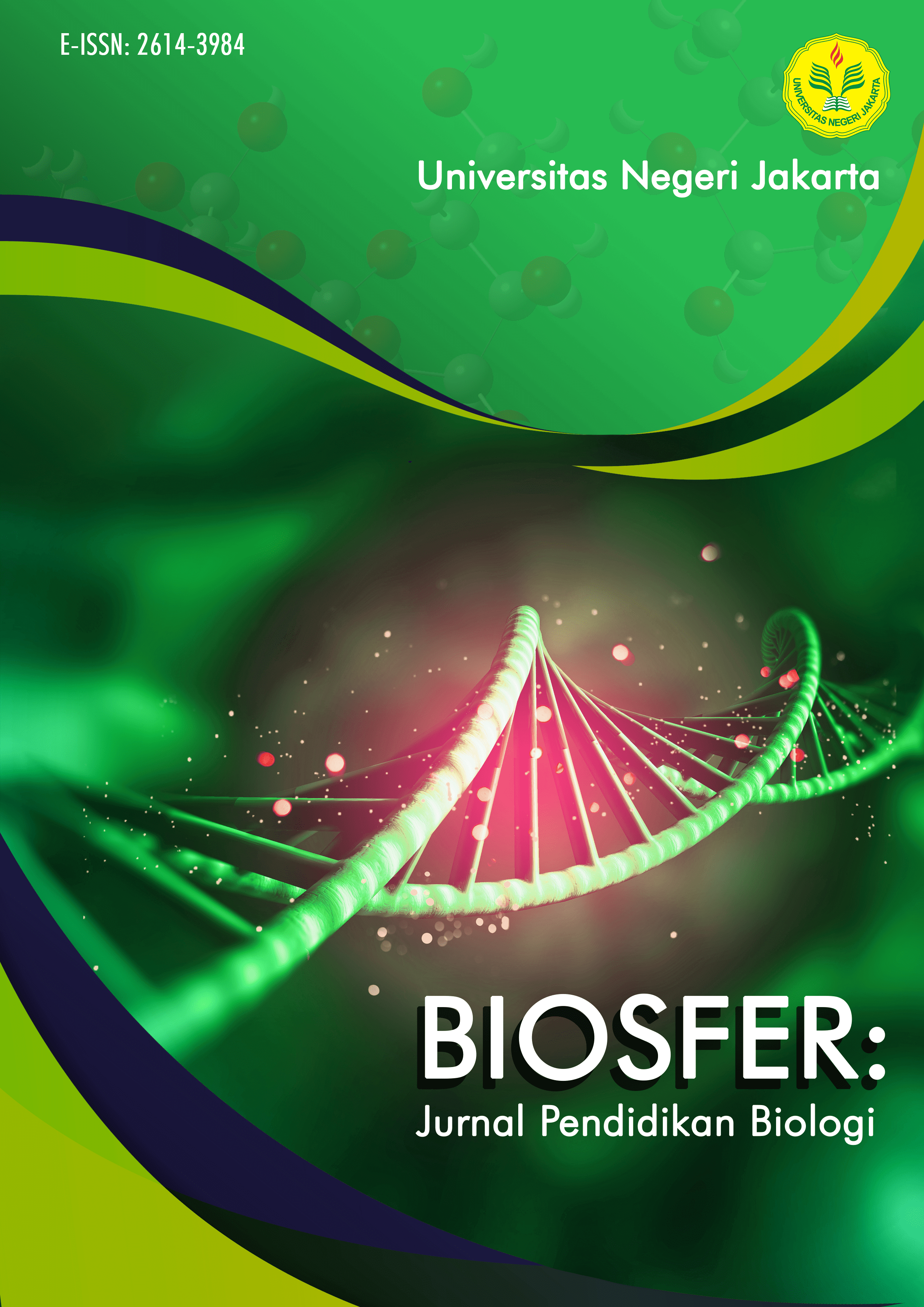The effect of respiratory augmented reality media on analysis and evaluation skills of eight grades students
DOI:
https://doi.org/10.21009/biosferjpb.23142Keywords:
Augmented Reality, Higher Order Thinking Skills, Respiratory SystemAbstract
The use of learning media on respiratory system material is needed so that the material presented can be understood thoroughly. One of the media that can be used to visualize the respiratory system material is Augmented Reality (AR). The purpose of this study was to determine the effect of using AR media on improving students' higher order thinking skills on the respiratory system material for class VIII at SMP Negeri 12 Bandar Lampung. The method used in this study is a quasi-experimental method with a non-equivalent pretest-posttest design. The sampling technique in this study used a purposive sampling technique. The research sample used was students of class VIII A as the experimental class and VIII C as the control class, with a total sample of 62 students. The data on the average value of pretest, posttest, and N-Gain as a result of the increase in students were analyzed by using the Independent Sample t-test. The results showed that the HOTS ability of students was in the medium category with N-gain in the experimental class of 0.58 ± 0.21 and the HOTS ability of students in the low category with N-gain in the control class was 0.29 ± 0.14. Statistical analysis with T-test showed that the use of AR media had a significant effect on increasing students' HOTS.
References
Anderson, L, W., & Krathwohl, D. R. (2001). Taxonomy for learning, teaching, and assessing: a revision of Bloom’s taxonomy of education objectives. NEW YORK: NY : Longman.
Arikunto, S. (2006). Prosedur Penelitian Suatu Pendekatan Praktik. Jakarta: Rineka Cipta.
Arsyad, A. (2013). Media Pembelajaran Edisi Revisi. Jakarta: PT. Rajagrafindo Persada.
Azhar, A. (2010). Media Pembelajaran. Jakarta: Rajawali Pers.
Hamalik, O. (1994). Media Pendidikan. Jakarta: PT Cita Aditya Bakti.
Heong, Mei, Y. (2011). The Level of Marzano Higher Thinking Skills Among Technical Education Students. International Journal of Social Science and Humanity, 1(2), 121–125. http://www.ijssh.org/index.php?m=content&c=index&a=show&catid=23&id=282
Hidayati, S. (2007). Sains Biologi 2 SMA/MA. Jakarta: Bumi Aksara.
Junaengsih, N. (2015). Penggunaan Media Video Animasi Sistem Pernapasan Manusia Untuk Meningkatkan Hasil Belajar Biologi. Jurnal Edusains., 7(1), 57-63. https://doi.org/10.15408/es.v7i1.1215
Lai, J. Y., & Chang, L. T. (2021). Impacts of Augmented Reality Apps on First Graders’ Motivation and Performance in English Vocabulary Learning. SAGE Open, 11(4). https://doi.org/10.1177/21582440211047549
Liono, R. A., Amanda, N., Pratiwi, A., & Gunawan, A. A. S. (2021). A Systematic Literature Review: Learning with Visual by the Help of Augmented Reality Helps Students Learn Better. Procedia Computer Science, 179, 144–152. https://doi.org/10.1016/j.procs.2020.12.019
Manik, P. (2020). kemampuan berfikir tingkat tinggi dalam menyelesaikan soal HOTS mata pelajaran matematika. Jurnal Ilmiah Sekolah Dasar, 4(2), 254–269. https://doi.org/10.23887/jisd.v4i2.25336
Mauludin, R., Sukamto, A. S., & Muhardi, H. (2017). Penerapan Augmented Relty Sebagai Media Pembelajaran Sistem Pencernaan pada Manusia dalam Mata Pelajaran Biologi. Jurnal Edukasi Dan Penelitian Informatika (JEPIN), 3(2), 117–123. https://jurnal.untan.ac.id/index.php/jepin/article/view/22676
Muhson, A. (2010). Pengembangan Media pembelajaran Berbasis Teknologi Informasi. Jurnal Pendidikan Akuntansi Indonesia, 8 (2), 1–10. https://doi.org/10.21831/jpai.v8i2.949
Muthoharoh, M. (2020). Inovasi Pembelajaran Pendidikan Agama Islam Berbasis HOTS (Higher Order Thinking Skill). Journal of Islamic Education., 5(2), 131–143. https://ejournal.stitmuhbangil.ac.id/index.php/jie/article/view/181
Nurhayati, S. (2014). Pengaruh Video Animasi Terhadap Hasil Belajar Siswa Kelas XI SMAN 5 Pontianak Pada Materi Kesetimbangan Kimia. Artikel Penelitian, 2(2), 1-11. https://jurnal.untan.ac.id/index.php/jpdpb/article/view/6058
Nuri, Arina, D. (2014). Pengaruh Penggunaan Video Animasi Terhadap Hasil Belajar Perubahan Kenampakan Bumi Siswa Kelas IV SD Tamanan 2 Bondowoso. Jurnal Ilmiah Mahasiswa, 2 (1), 1-25. http://repository.unej.ac.id/handle/123456789/63079
Prasetyo, B. (2018). Metode Penelitian Kuantitatif. Jakarta: PT Raja Grafindo Persada.
Rusman, D. (2012). Pembelajaran Berbasis Teknologi Informasi dan Komunikasi, Cetakan kedua. Jakarta: Raja Grafindo Persada.
Sanusi, A. (2013). Metodologi Penelitian Bisnis. sumatra: Cetakan Ketiga.
Sartono, handayani., rusdi., H. (2017). pengaruh pembelajaran process oriented guided inquiry learning (pogil) dan discovery learning terhadap kemampuan berpikir analisis siswa SMAN 24 jakarta pada materi sistem imun. Jurnal Pendidikan Biologi (Biosferjpb), 10(1), 58–64. https://doi.org/10.21009/biosferjpb.10-1.8
Sari, D. S., Jalmo, T., & Rakhmawati, I. (2021). Analisis Efektivitas Pembelajaran Daring terhadap Hasil Belajar Kognitif Peserta Didik. Jurnal Bioterdidik: Wahana Ekspresi Ilmiah, 9(1), 59-69. http://dx.doi.org/10.23960/jbt.v9i1.22294
Sugiyono. (2011). Metode Penelitian Kuantitatif, Kualitatif dan R&G. Bandung: Alfabeta.
Suwarno, T. (2015). Penggunaan Media Video Animasi Sistem Pernapasan Manusia Untuk Meningkatkan Hasil Belajar Biologi. Jurnal Edusains, 7(1), 57–63. https://doi.org/10.15408/es.v7i1.1215
Yosi, R. Gili MA. Ruth, S. (2008). Using A Computer Animation To Teach High School Molecular Biology. Journal Of Science Education Technology, 17(1), 49–51. https://link.springer.com/article/10.1007/s10956-007-9080-4
Downloads
Published
How to Cite
Issue
Section
License
The Authors submitting a manuscript do so on the understanding that if accepted for publication, copyright of the article shall be assigned to Biosfer: Jurnal Pendidikan Biologi (Biosferjpb) and Departement of Biology Education, Universitas Negeri Jakarta as publisher of the journal.



